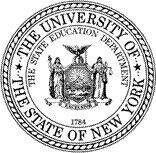Meeting of the Board of Regents | September 2007
|
From the New York State Board of Regents |

|
|
Regents of The University of The State of New York Robert M. Bennett, Chancellor,Tonawanda | Merryl H. Tisch, Vice Chancellor, New York |
||
|
September 2007
This year marks the beginning of an historic opportunity for children and schools in New York State. The Board of Regents recently adopted its agenda for P-16 Education, P-16 Education: A Plan for Action, which includes, among other things, a plan to support the important work of school districts, enhance accountability measures, and improve student achievement. Closely aligned with this Plan, the new 2007-08 State budget includes an unprecedented increase of $1.7 billion in aid to school districts across the State. With the action plan and resources as the foundation for the future of education in this State, the Board of Regents and State Education Department are moving forward aggressively to implement the actions needed to accomplish the vision and goals for education that we share with the Governor and the Legislature. Some highlights of our recent work include: Contracts for Excellence Beginning this year, school districts receiving substantial additional State Aid must use the resources to put in place proven, effective programs to raise student achievement. To meet the timelines established in the Budget, after extensive consultation with the field, the Regents adopted Regulations by emergency action in April so that school districts would have critical information to develop their Contracts for the 2007-08 school year. We have provided guidance to the field and met one-on-one with districts that are required to submit the Contracts. We will provide technical assistance to help them utilize the new funds to support students with the greatest educational needs and to supplement and not supplant existing district efforts. Specific school by school goals are expected and best practices will be a key component of this policy and strategy. Universal Pre-K In collaboration with the New York Council on Children and Families, Head Start Collaboration Project, and the New York State Child Care Coordinating Council the Department convened seven workshops across the State to provide technical assistance to districts receiving additional funding for Universal Pre-K programs. Regulations adopted in May require all Universal Pre-kindergarten programs to align their curricula with State learning standards; construct early literacy programs based on effective, evidence-based instruction, regularly assess the progress of all children, and ensure that program effectiveness is being tracked by the sponsoring agency. We are also regulating class sizes and requiring schools and other organizations to provide professional development, have procedures to ensure parental involvement, and provide support services. Approximately 390 local educational agencies statewide will be implementing Pre-K programs in 2007-08; one-third of which are new programs. Accountability and School Improvement We are strengthening New York’s accountability system to incorporate a growth model that will measure individual student progress from year to year. At the same time, we are strengthening the measure of accountability, including student retention, graduation, and college attendance and completion. We are also extending the State Education Department’s school improvement services to provide added support to schools within the financial resources underwritten by the state budget. Learning Standards Review Both the Regents P-16 Plan and the State Budget call for a review of the State’s Learning Standards to determine if they should be strengthened or modified in view of advances made and new expectations of a changed economy. As before, this review will bring together academic and research experts, teachers, administrators, business leaders, and others. A schedule for this review that includes the extensive involvement of the field is being developed now. Drafts of the revised standards will be circulated widely for public comment before final adoption as was the case a decade ago. Revision of the standards will likely necessitate the review and revision of state assessments that are aligned with the standards, teacher preparation, and professional development. Involvement of the field at all phases of this work will be critical in order to ensure that the necessary alignment takes place in a way that is meaningful and relevant to students, teachers, teacher education programs, parents and colleges and universities. Special Education Students with disabilities are making progress academically, but their performance is still too low. We have set targets for schools to meet and are holding low-performing school districts accountable. We have designated 69 school districts for an increased level of intervention and are requiring them to use their funds in proven ways to raise achievement. Children are most often referred unnecessarily to special education because of difficulties reading or behavior problems. We are also targeting our own resources to train district personnel in reading and behavioral intervention.
Sincerely,
The University of the State of New York (USNY) is the most complete, interconnected system of educational services in the United States. USNY includes: 7,000 public and private elementary and secondary schools; 248 public and private colleges and universities; 251 proprietary (for-profit) schools; nearly 7,000 libraries; 750 museums; the State Archives; vocational rehabilitation and other services for adults with disabilities; special education services for pre-school and school-age children; a School for the Blind; a School for the Deaf; 25 public broadcasting facilities, including nine public television stations; more than half a million professionals practicing in 47 licensed professions, and 200,000 certified public school teachers, counselors, and administrators. |




